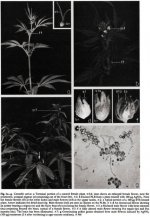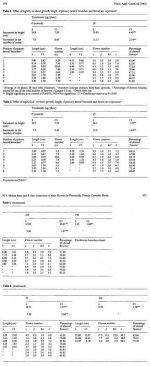I don't have the full 1.3mb PDF of this (anybody got a spare $35?  ), but there's still a lot of good info on the first page which i present here.
), but there's still a lot of good info on the first page which i present here.
For those not aware, certain substances that affect ethylene production such as colloidal/ionic silver, silver theosulphate, giberrilic acid etc can be used to force a female plant to produce pollen. Any plants then pollenated as a result will produce feminised seeds - they will all grow into females, because the pollen is from a female - not a male (as per regular seeds).
See the link in my signature for an easy DIY guide which uses colloidal silver (easier and safer to use than gibberillic acid/silver nitrate/silver thiosulphate), plus you can even easily make it yourself if you want!). There is also a distinct quote in this university paper that describes how colloidal silver was much more effective than gibberrelic acid.
Induction of Fertile Male Flowers in Genetically Female Cannabis Sativa Plants by Silver Nitrate and Silver Thiosulphate Anionic Complex
H.Y. Mohan Ram and R. Sett
Department of Botany, University of Delhi, Delhi (India), 1982
Summary
Apical application of silver nitrate (AgNO~ ; 50 and 100 ~μg per plant) and silver thiosulphate anionic complex (Ag(S203)~-; STS; 25, 50 and 100 ~μg per plant) to female plants of Cannabis sativa induced the formation of reduced male, intersexual and fully altered male flowers on the newly formed primary lateral branches (PLBs); 10 ~μg per plant of AgNO3 was ineffective and 150 ~μg treatment proved inhibitory. A maximum number of fully altered male flowers were formed in response to 100 ~μg STS. The induced male flowers produced pollen grains that germinated on stigmas and effected seed set. Silver ion applied as STS was more effective than AgNO3 in inducing flowers of altered sex. The induction of male flowers on female plants demonstrated in this work is useful for producing seeds that give rise to only female plants. This technique is also useful for maintaining gynoecious lines. [note - gynoecious means the plant only produces female flowers, for example if your friend gives you a female clone and you needed to make seeds from it you could use these tricks]
Introduction
Sex expression in flowering plants is regulated by genetic, environmental and hormonal factors. There is evidence that specific endogenous hormones play an important role in maintaining the genetic sex, and that sex can be modified through exogenous growth regulators, especially in the sexually polymorphic systems (Heslop-Harrison 1964). In general gibberellins favour male sex expression and auxin, ethylene and cytokinins promote female sex expression in various monoecious and dioecious systems (Mohan Ram 1980). Treatments which reduce the ethylene level in the tissues (hypo-baric conditions, treatment with benzothiodiazole) or antagonize the action of ethylene (CO2) cause the formation of male or bisexual flowers in place of female ones (Byers et al. 1972). Recently silver ion has been shown to interfere with ethylene action, presumably at the ethylene receptor sites (Beyer 1976a). Following the report by Beyer (1976b) that the application of silver nitrate (AgNOs) initiates male flower formation in gynoecious cucumber, it has been recently shown in four cucumber lines that silver ion is superior to GA3 (gibberillic acid) for male flower induction (Kalloo 1978; Tolla and Peterson 1979). In the pistillate 240 line of Ricinus communis (Ankineedu and Rao 1973) an internodal injection of aqueous silver nitrate solution induced fertile male flowers on the strictly pistillate primary terminal raceme (Mohan Ram and Sett 1980). Using labelled silver (110 m Ag), Veen and van de Geijn (1978) showed that silver applied as silver thiosulphate anionic complex (STS) is transported faster (2 mh-l) than AgNO3 (3 cm day -1) and that it completely counteracts the ethylene effect and significantly extends the vase-life of carnations (Veen 1979). A preliminary report from this laboratory showed that apical application of silver nitrate (100 ~μg/plant) induces fertile male flowers in female Cannabis plants (Sarath and Mohan Ram 1979). The present investigation was undertaken with the objective of establishing the minimal and optimal dosage of AgNO~ required to modify the sex expression of female plants of Cannabis sativa and also to find out whether STS acts as an ethylene antagonist in male sex induction.
For those not aware, certain substances that affect ethylene production such as colloidal/ionic silver, silver theosulphate, giberrilic acid etc can be used to force a female plant to produce pollen. Any plants then pollenated as a result will produce feminised seeds - they will all grow into females, because the pollen is from a female - not a male (as per regular seeds).
See the link in my signature for an easy DIY guide which uses colloidal silver (easier and safer to use than gibberillic acid/silver nitrate/silver thiosulphate), plus you can even easily make it yourself if you want!). There is also a distinct quote in this university paper that describes how colloidal silver was much more effective than gibberrelic acid.
Induction of Fertile Male Flowers in Genetically Female Cannabis Sativa Plants by Silver Nitrate and Silver Thiosulphate Anionic Complex
H.Y. Mohan Ram and R. Sett
Department of Botany, University of Delhi, Delhi (India), 1982
Summary
Apical application of silver nitrate (AgNO~ ; 50 and 100 ~μg per plant) and silver thiosulphate anionic complex (Ag(S203)~-; STS; 25, 50 and 100 ~μg per plant) to female plants of Cannabis sativa induced the formation of reduced male, intersexual and fully altered male flowers on the newly formed primary lateral branches (PLBs); 10 ~μg per plant of AgNO3 was ineffective and 150 ~μg treatment proved inhibitory. A maximum number of fully altered male flowers were formed in response to 100 ~μg STS. The induced male flowers produced pollen grains that germinated on stigmas and effected seed set. Silver ion applied as STS was more effective than AgNO3 in inducing flowers of altered sex. The induction of male flowers on female plants demonstrated in this work is useful for producing seeds that give rise to only female plants. This technique is also useful for maintaining gynoecious lines. [note - gynoecious means the plant only produces female flowers, for example if your friend gives you a female clone and you needed to make seeds from it you could use these tricks]
Introduction
Sex expression in flowering plants is regulated by genetic, environmental and hormonal factors. There is evidence that specific endogenous hormones play an important role in maintaining the genetic sex, and that sex can be modified through exogenous growth regulators, especially in the sexually polymorphic systems (Heslop-Harrison 1964). In general gibberellins favour male sex expression and auxin, ethylene and cytokinins promote female sex expression in various monoecious and dioecious systems (Mohan Ram 1980). Treatments which reduce the ethylene level in the tissues (hypo-baric conditions, treatment with benzothiodiazole) or antagonize the action of ethylene (CO2) cause the formation of male or bisexual flowers in place of female ones (Byers et al. 1972). Recently silver ion has been shown to interfere with ethylene action, presumably at the ethylene receptor sites (Beyer 1976a). Following the report by Beyer (1976b) that the application of silver nitrate (AgNOs) initiates male flower formation in gynoecious cucumber, it has been recently shown in four cucumber lines that silver ion is superior to GA3 (gibberillic acid) for male flower induction (Kalloo 1978; Tolla and Peterson 1979). In the pistillate 240 line of Ricinus communis (Ankineedu and Rao 1973) an internodal injection of aqueous silver nitrate solution induced fertile male flowers on the strictly pistillate primary terminal raceme (Mohan Ram and Sett 1980). Using labelled silver (110 m Ag), Veen and van de Geijn (1978) showed that silver applied as silver thiosulphate anionic complex (STS) is transported faster (2 mh-l) than AgNO3 (3 cm day -1) and that it completely counteracts the ethylene effect and significantly extends the vase-life of carnations (Veen 1979). A preliminary report from this laboratory showed that apical application of silver nitrate (100 ~μg/plant) induces fertile male flowers in female Cannabis plants (Sarath and Mohan Ram 1979). The present investigation was undertaken with the objective of establishing the minimal and optimal dosage of AgNO~ required to modify the sex expression of female plants of Cannabis sativa and also to find out whether STS acts as an ethylene antagonist in male sex induction.
Last edited:





